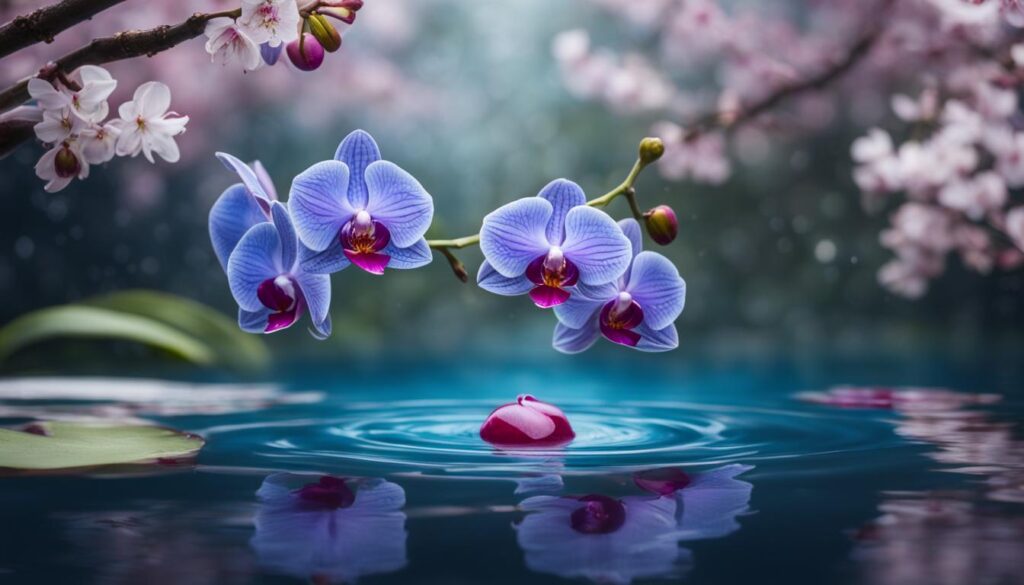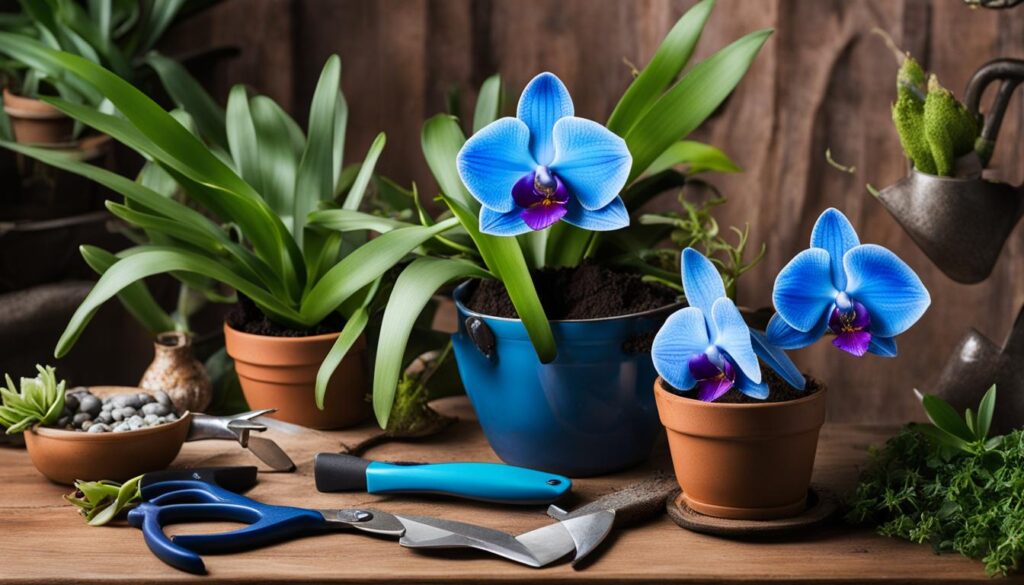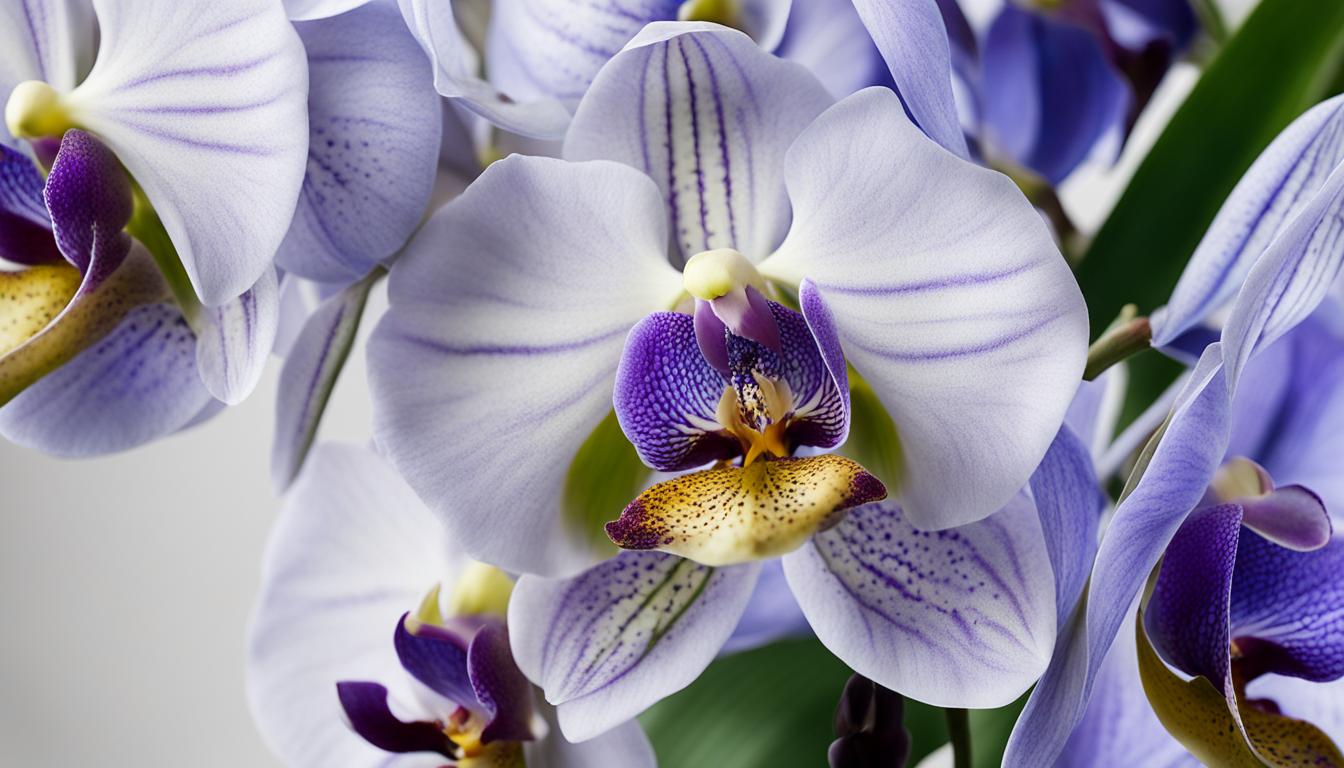Did you know that out of the over 25,000 species of orchids, a mere handful exhibit a natural shade of blue? This striking rarity makes real blue orchids some of the most sought-after flowers among collectors and horticulture enthusiasts.
As I dive into the enchanting world of blue orchids, I’ll help you navigate the vibrant truths and misconceptions surrounding these botanical treasures, and even share insights on where to buy rare blue orchids and how to distinguish the authentic blooms with the ones that are temporarily dyed.
For those eager to add a touch of cobalt, azure, or indigo to their floral array, understanding the nuances of these rare blue orchids is essential, whether they’re blue orchids for sale at a local nursery or exotic picks from specialty vendors.
Blue orchids do not just charm the eye but also invite a sense of wonder in the natural world.
Many enthusiasts scour the market for blue orchids for sale, dreaming of owning a piece of this rarity.
If you’re looking to enhance your home or garden with these sapphiric beauties, this guide will provide you with the necessary knowledge to make informed choices, ensuring that your blue wonders are authentic and awe-inspiring.
Key Takeaways
- Discover the true rarity and appeal of blue orchids amongst a vast array of orchid species.
- Learn how to differentiate natural blue orchids from artificially colored ones.
- Gain insights into where you can purchase authentic and rare blue orchids.
- Find out why blue orchids hold a prized position in the world of horticulture.
- Understand the importance of setting accurate expectations when searching for blue orchids for sale.
- Appreciate the beauty and uniqueness of blue orchids, both natural and altered, in home decor.
Unveiling the Mystery of Blue Orchids
As a plant enthusiast with a fervent interest in the enchanting world of orchids, the question of whether blue orchids are real is one that frequently captures my curiosity.
Blue flowers are an uncommon spectacle in nature, and blue orchids, with their surreal and vivid hues, stand as botanical treasures within this rare palette.
Are Blue Orchids Real?
Astonishingly, true blue orchids do exist, defying the common misconception that blue hues in flowers are purely the result of human intervention.
Vanda coerulea and Thelymitra crinita are exemplary real blue orchids that have captured the hearts of many with their natural azure tones.
However, these varieties are exceedingly rare, compounding the allure and marvel surrounding blue orchids.
The Process Behind Creating Blue Orchids
On the commercial side, the orchid market has ingeniously introduced ‘blue’ orchids through a process that involves infusing white Phalaenopsis orchids with a specially formulated blue dye.
While the resulting blue orchid bouquet displays a breathtakingly deep blue, this color is temporary, with future blooms often returning to their original white.
It’s a fascinating play of aesthetics, extending the reach of blue orchids to those who seek their beauty far and wide.
Natural Vs. Artificial: Understanding Blue Orchid Coloration
Distinguishing between natural and artificially colored blue orchids is an essential part of blue orchid care.
For those looking for authenticity in their flora, acquiring a real blue orchid is a moment of elation.
Conversely, the artificially created ones, while beautiful, serve as a reminder to manage expectations regarding the longevity of color and plant care.
The following table outlines the contrast between these two types of blue orchids:
| Aspect | Natural Blue Orchid | Artifically Colored Blue Orchid |
|---|---|---|
| Color Source | Genetic pigmentation | Dye injection |
| Longevity of Blue Color | Persistent across blooms | Temporary, only present in treated blooms |
| Price Comparison | Often higher due to rarity | Typically twice the cost of non-dyed counterparts |
| Availability for Delivery | Rare and seasonal | Widely available for blue orchids delivery |
| Care Requirements | Specialized according to species | Standard Phalaenopsis orchid care |
To conclude this section, improper knowledge about blue orchids might result in misguided purchases.
Whether your heart desires a naturally occurring blue orchid or you wish for the fleeting marvel of a dyed blue orchid bouquet, it’s imperative to understand and offer the correct care for blue orchids to ensure their beauty endures.
Cultural Significance and Symbolism of Blue Orchids
When I delve into the world of blue orchids flowers, I’m often struck by their ethereal hues and the profound blue orchids meaning they hold across cultures.
These botanical treasures are much more than a visual delight; they carry a heritage of blue orchids symbolism that enriches their allure.
Their scarcity and distinctive coloration spark a tapestry of meanings that paint these flowers as symbols of not just beauty, but also of spiritual depth and emotional resonance.

Considered emblematic of rarity and individuality, blue orchids resonate with the human quest for the extraordinary.
Their cool, tranquil blue mirrors the infinite reach of both the sky and the sea, offering a sense of mystery and enigmatic charm that captivates the soul.
The following table outlines the various symbolic interpretations attributed to blue orchids:
| Cultural Significance | Meaning and Symbolism |
|---|---|
| Elegance and Sophistication | Associated with regality and poise, they’re a favorite for events that celebrate exclusivity and high status. |
| Emotional Depth | They convey intense feelings of desire and sensuality, making them perfect for intimate gestures and romantic expressions. |
| Royalty and Power | Their royal blue hues reflect attributes of leadership and commanding power. |
| Tranquility and Peace | Their calm blue vibe brings forth a sense of serenity, ideal for environments meant to soothe and relax. |
Moreover, in many societies, these blooms typify traits of fertility and charm, adding a layer of depth to their already fascinating existence.
Part of the beauty in giving or receiving blue orchids is the acknowledgment of these layered meanings, acknowledging the thoughtfulness invested in the choice of such a flower.
In conclusion, my interaction with blue orchids is always heightened by the awareness of their significant cultural and symbolic role.
Each blue orchid flower whispers tales of allure and mystique, beckoning those who encounter them to pause and reflect on the unspoken words they carry through colors and shapes.
Blue Orchids Care and Cultivation Secrets
As someone deeply passionate about botany, particularly the majestic blue orchid, I’ve dedicated countless hours to understanding how to grow blue orchids effectively.
Let me share some blue orchid care tips and secrets that will help you cultivate these alluring blooms successfully.
Optimal Growing Mediums for Blue Orchids
For the spectacular blue orchid, selecting the right growing medium is crucial. I’ve found that a custom mix provides the best support for their roots and overall growth.
Here’s a table that details the ideal components of a growing medium for nurturing these beauties:
| Component | Benefit |
|---|---|
| Coconut Fiber | Ensures good aeration and moisture retention |
| Dried Fern Roots | Creates a natural, airy support structure |
| Peat Moss | Maintains moisture and acidity levels |
| Sphagnum Moss | Exceptional for water retention and root support |
| Cork Pieces | Allows the roots to breathe and prevents rot |
| Fir Bark | Provides a robust structure and drainage |
| Rock Wool | Assists in retaining water and nutrients |
| Perlite | Helps keep the mix light and well-draining |
| Lava Rock | Facilitates drainage and proper root anchorage |
It’s vital to ensure your growing medium is evenly mixed to allow for the balanced growth of the blue orchids.
Also, considering the best homemade fertilizers for orchids can be a game-changer in nurturing these particular plants.
Watering and Humidity Preferences of Blue Orchids
I’ve observed that while blue orchids adore humidity, being mindful of watering is key to their survival.
The trick lies in maintaining an equilibrium—providing enough water without causing the roots to sit in moisture, which can quickly lead to root rot. Here’s how I manage their watering and humidity requirements:
- Water once every 7-9 days, allowing the growing medium to dry slightly between watering sessions.
- Keep indoor humidity levels at a lush 60-80% to mimic their natural tropical environment.
- Use a humidity tray or a room humidifier if needed; it’s an excellent strategy that I’ve personally found effective.
Consistent monitoring and adjustments will ensure your blue orchids receive just the right amount of hydration.
Fertilization: Nourishing Your Blue Orchid
Fertilizing your blue orchid can be likened to feeding it; both timing and composition matter immensely.
I like to use a balanced, high-nitrogen fertilizer, or even better, create a weak homemade blend, to promote vibrant growth and blooms. Here’s my approach:
- Apply a diluted fertilizer solution (30-10-10, 10-10-10, or 10-10-30) at half strength.
- Fertilize once every 5-6 weeks—a light touch goes a long way.
- Homemade fertilizers, such as banana peel water or eggshell tea, can also provide essential nutrients with natural simplicity.
By carefully nourishing your blue orchids, you’ll be rewarded with their intriguing and attractive flowers, which capture the hearts of plant lovers everywhere.

Conclusion
As I draw this guide to a close, it is crucial to recognize that blue orchids truly are a jewel in the crown of horticulture.
They carry an air of mystique, often tangled in myths that hide their authentic grace.
These rare blue orchids have captivated the hearts of many, garnering a special place in the gardens and collections of plant lovers across the United States.
Rarity and Splendor of Blue Orchids in Horticulture
The rarity of genuine specimens like Vanda coerulea cannot be overstated; they embolden enthusiasts to continue the thrilling hunt for these elusive blooms.
My experience tells me that every blue orchid, whether for sale or display, commands attention with the elegance it brings.
This allure is a testament to its revered status among the palette of orchid varieties.
Dispelling Myths and Embracing True Blue Orchids
The myths surrounding blue orchids often paint them as a figment of the imagination, but I’ve learned that their existence is as tangible as the soil in which they grow.
Distinguishing the dyed from the natural is key to embracing their true beauty. The meaning that each blue orchid carries, be it in a bouquet delivery or a conservatory’s collection, resonates deeply within the culture of plant preservation and appreciation.
Whether enthralled by their symbolism or eager to add a touch of this splendor to your surroundings, blue orchids promise to deliver an exotic charm that is hard to overlook.
FAQ
Are there truly rare blue orchids in nature?
Yes, genuine blue orchids do exist in nature but they are incredibly rare. Species like the Vanda coerulea and Thelymitra crinita are examples of naturally occurring blue orchids. These are often sought after by enthusiasts and collectors due to their rarity and stunning appearance.
Where can I buy blue orchids?
Blue orchids can be purchased from specialized orchid growers, botanical gardens with sales departments, or online retailers that specialize in rare plants. Keep in mind that you may come across artificially colored blue orchids more commonly than the natural ones. It’s important to verify whether you’re buying a dyed plant or a naturally blue species.
Are blue orchids delivered as live plants or cut flowers?
Blue orchids can be delivered as both live plants and cut flowers, depending on the supplier and your preference. When ordering, specify whether you want an orchid plant to grow at home or a bouquet of blue orchids for decorative purposes.
Can I grow blue orchids at home?
Yes, you can grow blue orchids at home, although they require meticulous care. It’s important to educate yourself on the specific needs of the orchid species you choose, such as their light, water, humidity, and soil preferences. For dyed blue orchids, the care process is the same as for other Phalaenopsis orchids once the dye fades and the blooms return to their original color.
What is the significance and symbolism of blue orchids?
Blue orchids symbolize rarity, beauty, elegance, and spirituality. They are often associated with individuality and uniqueness due to their unusual color. In certain cultures, blue flowers represent tranquility, peace, and deep emotional significance such as desire, sensuality, and romantic feelings.
How can I distinguish between a naturally blue orchid and one that has been dyed?
Naturally blue orchids often have a softer, more pastel blue hue, while dyed blue orchids are typically a vibrant, striking blue. Additionally, when repotting or examining the plant closely, you may notice dye concentrations at the base of a dyed orchid’s stem. Sellers usually inform customers if an orchid has been artificially colored, so it’s always a good practice to ask when purchasing.
What is the optimal growing medium for a blue orchid?
An optimal growing medium for blue orchids generally includes a mix of several components such as coconut fiber, sphagnum moss, dried fern roots, perlite, and fir bark. These components provide the right balance for proper drainage and aeration crucial for the healthy growth of an orchid.
What are the watering and humidity preferences for blue orchids?
Blue orchids typically prefer a watering schedule of once every 7-9 days, but this can vary depending on the humidity and temperature. They thrive in humidity levels between 60-80%. It’s critical to ensure the orchid’s roots aren’t sitting in water, as this can lead to root rot.
What type of fertilizer should I use for blue orchids?
A balanced fertilizer such as 10-10-10 or 30-10-10 is suitable for blue orchids. It should be used at half the recommended strength and applied every five to six weeks. Make sure to water the orchid first before fertilizing to protect the roots from chemical burn.
Can a blue orchid revert to its original color after being dyed?
Yes, if you buy a dyed blue orchid, such as the commonly available blue Phalaenopsis, it will revert back to its original white or pale color after the first bloom cycle. The dye does not alter the genetic makeup of the orchid, so the new blooms will show the orchid’s natural color.
Is a blue orchid more expensive than other orchids?
Depending on the species and whether it is naturally blue or artificially dyed, a blue orchid can be more pricey than its more common counterparts. Natural blue orchids are particularly costly due to their rarity, while dyed blue orchids may also command a higher price than the traditional white Phalaenopsis because of their novelty appeal.
What care tips should I follow to ensure my blue orchid blooms well?
To ensure your blue orchid blooms well, provide it with an environment that mimics its natural habitat—adequate indirect light, proper humidity, a suitable growing medium, and a consistent watering schedule. Fertilize sparingly with a balanced fertilizer, and maintain the optimal temperature range specific to the orchid’s species. If you have a dyed blue orchid, continue to care for it as you would a normal Phalaenopsis orchid post the dye fading.


Leave a Reply